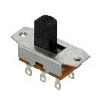
Ray Wilson authored this content while he was actively running MFOS as the founder and resident genius.
We retain the content because it reflects a valuable point of view representing that time and place.
Switch Images borrowed for educational use from
Futurlec,
Jameco and
All Electronics.
Buy switches through Small Bear Electronics

|
I only show toggle switches below because they are both easy to mount and widely available. Slide switches (example at left) of the same ilk (SPST, SPDT, DTDT, etc.) are cheaper and will provide the same function but they are a pain to mount (unless you have a rectangular drill). Shop around switch prices can vary A LOT. If you can find surplus even better! This is NOT a comprehensive switch index there are lots of variations and types (foot switches, micro-switches, limit switches, etc.) but this will get you going and cover 99% of your synth-diy needs. |
| Switch Type | Schematic Symbol | Example |
|---|---|---|
| Single Pole Single Throw (SPST) These just switch one thing at a time. Its either on or off. Search parts supplier sites (or Google) for "SPST" or "switch". |  |
 |
| Single Pole Double Throw (SPDT) These switch the center pole to one or the other side poles. They also make this as a special center off version that has three positions. The center position causes the center pole not to touch either pole (thus center off). They are listed in catalogs as either ON-ON or ON-OFF-ON (center off version). Schematics will specifically call out the center off version when it is used. Search parts supplier sites (or Google) for "SPDT" or "switch". Notice that SPDT can be used as SPST if you find a good deal on SPDT switches. |  |
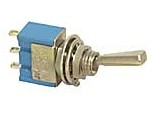 |
| Double Pole Double Throw (DPDT) These act like two SPDT switches with one bat. They also make this as a special center off version that has three positions. The center position causes the center poles not to touch either of their corresponding poles (thus center off). They are listed in catalogs as either ON-ON or ON-OFF-ON (center off version). Schematics will specifically call out the center off version when it is used. Search parts supplier sites (or Google) for "DPDT" or "switch". Notice that DPDT can be used as DPST, SPDT or SPST if you find a good deal on DPDT switches. | 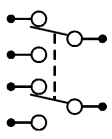 |
 |
| Single Pole Single Throw Momentary Push Button (SPST PB). These pushbuttons have two poles. For N.O. or normally open, when you push the button the two poles are connected until you release the button (thus momentary on). For N.C. or normally closed, when you push the button the two poles are disconnected until you release the button (thus momentary off). Top symbol is N.O. and the bottom symbol is N.C. Search parts supplier sites (or Google) for "SPST" or "pushbutton" or "switch". |   |
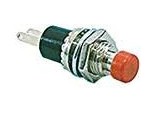 |
| Single Pole Single Throw Push-On Push-Off (SPST PB). These pushbuttons have two poles. Push it once to short the poles (close the switch) push it again to release the connection. These are good for the power button for your synth. The schematic will specify that the switch is push-on push-off (or latching) if this is the type needed. Search parts supplier sites (or Google) for "SPST" or "push-on push-off" or "switch". |  |
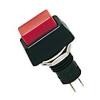 |
| Rotary Switches (nPnT) (that's n poles n throws). These are switches that you rotate to connect the common pole (or poles) to the switched poles. They come in many flavors of nPnT. Here 1P12T (1 pole 12 throw) is shown. Sometimes when you need, say for example, a 1 pole 4 throw you have to buy a 3P4T (or 3 Pole 4 Throw) switch and only use part of it. Search parts supplier sites (or Google) for "Rotary Switch" or "switch". |  |
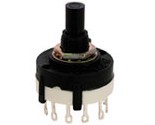 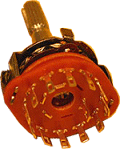 |